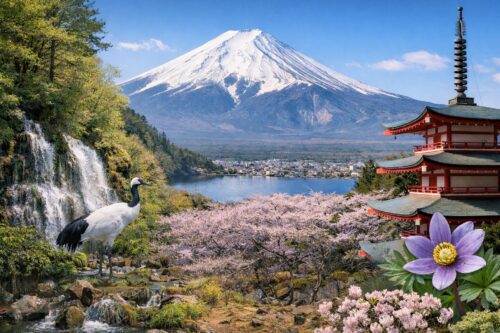Continuing from our previous exploration of the Fujinomiya Route’s history, this time we will learn about the Yoshida Trail (Yoshida-guchi Tohaido), now the most heavily used path to the summit of Mount Fuji.

Yoshida Trail: Historical Background
The Yoshida Trail, also known as the Yoshida-guchi Pilgrimage Path, stands as one of the two major traditional climbing routes leading to the summit, rivaling the Ōmiya-Murayama Trail. According to legend, this route may date back as far as the medieval period and is even said to have been opened by the mythical figure Prince Yamato Takeru.
With the emergence of the Fuji-ko religious associations, the Yoshida Trail became well-known. In 1733, Jikigyo Miroku (the Restorer of Fuji-ko) undertook a pilgrimage climb on this route and completed ritual fasting at Eboshi-iwa (at the 7th station, 7.5th level). After this, followers of the Fuji-ko movement (once said to number 808 groups in Edo alone) flocked to this trail, making it a vibrant and bustling pilgrimage path up until World War II.
However, in 1964, the opening of the Fuji Subaru Line road made it possible to access the mountain by car up to the 5th station. As a result, use of the original Yoshida Trail section between Kitaguchi Hongu Fuji Sengen Shrine and the 6th station declined dramatically, leaving many of the old mountain huts and religious sites in ruins.
Original Yoshida Trail Route
Traditionally, pilgrims would start at the Kitaguchi Hongu Fuji Sengen Shrine, stop at historic sites such as Otakayama (an old place of distant worship), then pass through Suzuhara Dainichi (1st station), Komuro Sengen Shrine (2nd station), Sangenchaya-do (3rd station), Gozaishi Sengen Shrine (4th station), Nakamiya Shrine (5th station), and Komitake Shrine (5.5th station), finally reaching Eboshi-iwa (7.5th station), Daigoai (8th station), Hinomiko (9th station), and the summit at Yakushi-dake (now known as Kusushi-dake). Although many of these sites are now abandoned, traces of them can still be found.
The Modern Yoshida Trail
Today, thanks to the Fuji Subaru Line, most climbers begin at the Fuji Subaru Line 5th Station (elevation 2,305m). The trail’s historical association with the Fuji-ko means that many climbers from the Tokyo metropolitan area still choose this route, making it the busiest of Mount Fuji’s four main trails—over half of all summit climbers use the Yoshida Trail.
The 5th station features numerous rest houses and shops, with people coming not only for climbing but also to visit Komitake Shrine or to enjoy the stunning views of the Yatsugatake and Southern Alps. As a result, it is a year-round tourist spot visited by non-climbers as well.
When climbing, the trail from the 5th station splits at Izumigataki toward the original Yoshida Trail and then proceeds to the 6th station. From there, the trail ascends toward the summit, passing more than 20 mountain huts at regular intervals between the 7th and the summit. Medical aid stations and security staff are available around the clock, making it arguably the best-supported mountain trail in Japan.
For the descent, the route differs from the ascent: from the 8th station, you descend using the same path as the Subashiri Trail, and after that, you follow a special gravel and volcanic ash path (known as the sand run) back to the 6th station, where the ascent and descent routes rejoin.
While the Fujinomiya Trail offers the quickest ascent and descent because it starts at a higher elevation, the Yoshida Trail is generally recommended for less-experienced climbers because of its more gradual slopes, excellent facilities, and strong support infrastructure. However, because this trail is so popular, expect crowds in the mountain huts and on the trail, especially during peak climbing season and at sunrise when visitors gather to see the famous “Goraikō” (sunrise from the summit).
Next time, we’ll look at the history and background of the other routes leading to the summit of Mount Fuji!






